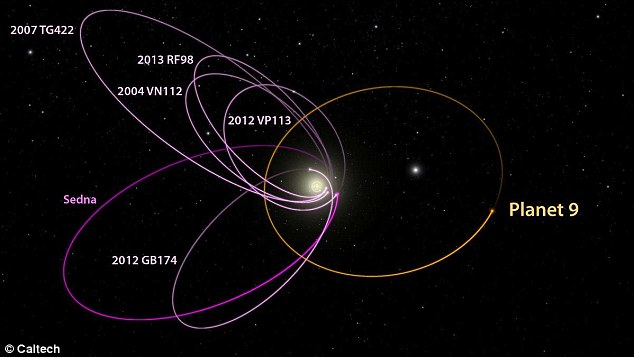
The scientist who had Pluto demoted to a dwarf planet (a spherical mass too large to be considered an asteroid but too small to be considered a true planet), has found a suitable replacement: he has found evidence that a gigantic frozen planet could exist past Neptune, on the very fringe of our solar system.
Planetary astronomer from Caltech University, Mike Brown, believes that the true ninth planet (for now given the distinguished name of “Planet Nine,” but which has also gone by the sexier moniker “Planet X”), takes 10,000 to 20,000 years to orbit our sun.
“This would be a real ninth planet,” said Brown in January. “There have only been two true planets discovered since ancient times, and this would be a third. It’s a pretty substantial chunk of our solar system that’s still out there to be found, which is pretty exciting.”
“Hey Planet Nine fans, a new eccentric KBO was discovered. And it is exactly where Planet Nine says it should be,” Brown said in a recent tweet.

KBO is short for Kuiper Belt Object. The Kuiper Belt is an enormous disk of comets, small icy objects and dwarf planets – trillions of objects from the formation of our solar system. It is home to three officially recognized dwarf planets, Pluto, Haumea and Makemake.
The ninth planet is believed to have 10 times as much mass as our Earth, and is four times as large. Its enormous mass even led Brown to conclude that it is “the most planet-y of the planets in the whole solar system.” He believes that the recently found KBO’s strange behavior provides even more justification for his assertion.
The problem with detecting a planet this far away, is that very little light reaches that region of space- visually confirming its existence is thus a problem. However, the effect of the gravitational forces exerted by such a massive object can be observed in the behavior of the smaller KBOs.
“We saw a strange signal in the data that meant something odd was going on in the outer Solar System,” Brown said to The Guardian in January. “All of these distant objects were lined up in a weird way and that shouldn’t happen. We worked through the mundane explanations, but none of them worked out.” Six KBOs were found to be lining up in an unusual orbit that is perpendicular to the plane of the solar system.
Now a seventh KBO has been found, apparently forced into an unusual position. The likely cause is an enormous force located where the ninth planet was predicted to be.
“I haven’t done the statistics yet, but I suspect this takes the probability of this being a statistical fluke down to ~.001% or so,” Brown said in another tweet.
“We plotted up the positions of those objects and their orbits, and they matched the simulations exactly,” said Professor Mike Brown, also from Caltech.
Dr Konstantin Batygin from Caltech noted that “although we were initially quite skeptical that this planet could exist, as we continued to investigate its orbit and what it would mean for the outer solar system, we became increasingly convinced that it is out there. For the first time in over 150 years, there is solid evidence that the solar system’s planetary census is incomplete.”
Brown’s hypothesis has not been published in a peer-reviewed journal yet. Of course, for some, no matter the outcome, Pluto will always be their ninth planet. For others, there’s Nibi- ahh…, let’s not go there for now.
Sources: Science Alert, Daily Mail, Space, Caltech, Space Reporter, The Verge, Yahoo News
This article (More Evidence Of Ninth Solar Planet, 10 Times as Massive as Earth, Discovered by Astronomers) is a free and open source. You have permission to republish this article under a Creative Commons license with attribution to the author(CoNN) and AnonHQ.com.





Hope they find it and name it Vulcan (Blacksmith to the Roman gods, cast out for being too ugly; perfect fit for such a distant and misfit planet)
As far as I conjecture.. It’s called Nibiru , and it’s been here before
Mister Mike Brown the planet it’s called Nibiru by the sumerian tablets.